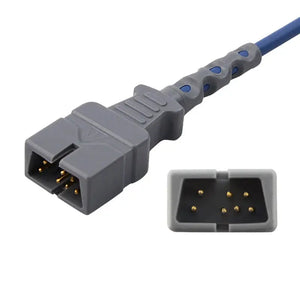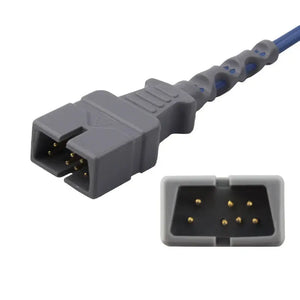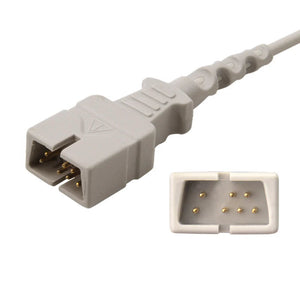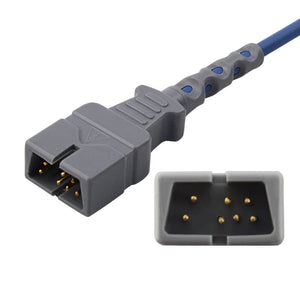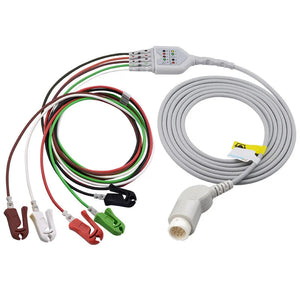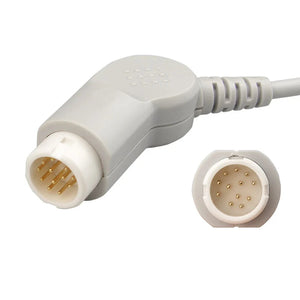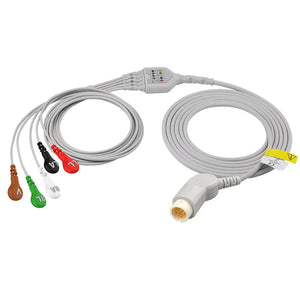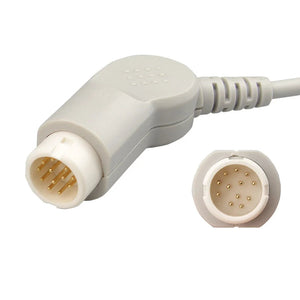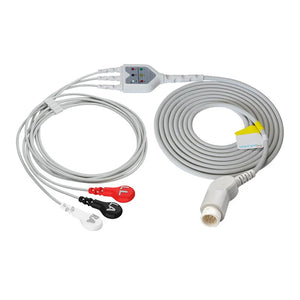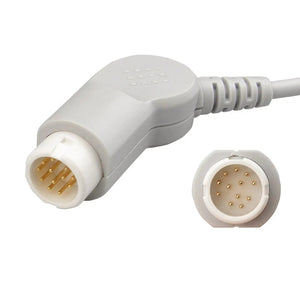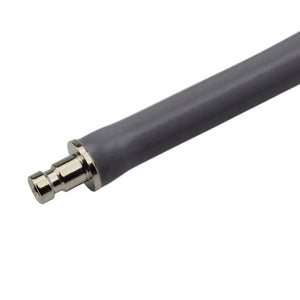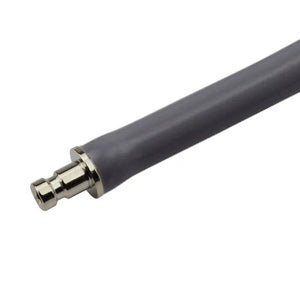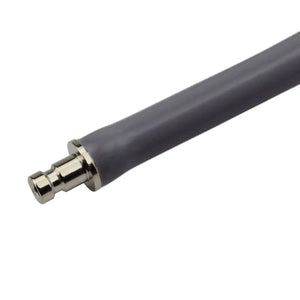Quick Summary: SpO2 sensors use red (~660 nm) and infrared (~940 nm) light with a photodiode to estimate arterial oxygen saturation from the pulse signal. Use transmissive probes (finger, toe, earlobe) for most patients, and switch to reflective probes (forehead or chest) when fingers and toes aren’t practical or peripheral perfusion is poor. Choose disposable sensors for infection control and OR workflows; choose reusable sensors for cost efficiency in lower-risk settings.
Last reviewed: • Reviewed by: MedLinket Clinical Education Team • Author: MedLinket Clinical Education Team
How SpO2 Sensors Work
An SpO2 sensor emits red and infrared light into perfused tissue. Because hemoglobin absorbs light differently when it is oxygenated versus deoxygenated, the detector measures the ratio of red to infrared light in the pulsatile component of the signal (arterial blood). Algorithms based on the Beer–Lambert principle convert that ratio into an estimate of arterial oxygen saturation.

Key takeaway: Clean signal in, reliable number out. Everything in this guide—technology, fit, placement, and motion control—exists to protect that signal.
Sensor Technologies: Transmissive vs. Reflective
Transmissive (through-transmission): The emitter and detector sit on opposite sides of a thin site such as a finger, toe, or earlobe. Use when digits are available and perfusion is adequate.
Reflective: The emitter and detector sit on the same side of the skin; light reflects from vascular beds on the forehead or chest. Use when hands are cold or vasoconstricted, digits are inaccessible, or when a forehead site is preferred during procedures.

Rule of thumb: Start with transmissive. If you’re chasing signal quality because of low perfusion or heavy motion, switch to reflective.
Types by Patient and Use
- Neonatal wraps: Soft wraps or adhesive bands around the foot or hand—gentle on tiny sites and suitable for continuous monitoring in the NICU.
- Infant/Pediatric sensors: Smaller clips or wraps sized for toes and fingers; color-coded leads are common.
- Adult finger clips/wraps: The everyday workhorse across med-surg units, the ICU, and the ED.
- Forehead reflective sensors: Helpful in the OR and ICU when digital sites fail.
- Specialty sites: Earlobe sensors often deliver robust signals and faster response times. See our pulse ox ear probe option.
Disposable vs. Reusable
Disposable: Ideal for the OR (Operating Room), ICU, and isolation protocols. They remove reprocessing time and help reduce cross-contamination, while offering consistent adhesive and placement. Explore our Disposable SpO2 Sensors collection.
Reusable: Cost-efficient for general units and outpatient settings. They require cleaning and regular inspection—choose durable materials and proper strain relief.
Tip: Many teams standardize on disposable sensors for high-risk use and rely on reusable sensors for routine care—backed by clear, written cleaning SOPs.
Accuracy & Common Errors (with Fixes)
- Poor perfusion (cold hands, shock): Warm the site, briefly lower the hand below heart level, or switch to the forehead or ear.
- Motion artifact (tremor, transport): Secure the cable, stabilize the limb, or consider a reflective forehead sensor.
- Ambient light (OR lamps, phototherapy): Shield the sensor with an opaque cover.
- Pigments (dark nail polish, henna, dyes): Remove nail polish or use a toe, ear, or forehead site.
- Improper size/fit: Use the age-appropriate sensor and avoid compressing tissue (venous pulsation distorts readings).
- Electrical/cable issues: Check for broken insulation, bent pins, or loose connectors.
Clinical note: Interpret SpO2 in context. The pleth waveform quality, a perfusion index (if your monitor provides one), and the patient’s presentation should align.
Placement Guide
- Choose the right site: Finger (index or middle), toe (for pediatrics), earlobe, or forehead (reflective).
- Prep the site: Remove nail polish, dry the skin, and warm the area if needed.
- Fit matters: Align the LEDs with the nail bed or vascular bed; avoid overtight wraps.
- Verify the signal: Look for a clean pleth and a stable reading for about 10–20 seconds.
- Secure the cable: Loop and tape the lead to minimize tugging during movement or transport.
Compatibility & Connectors
Oximeters use different connector styles and pinouts across platforms (for example, GE, Philips, Mindray, Nihon Kohden, Masimo-style, and Nellcor-style). Choose brand-compatible sensors or validated adapters and cables. When in doubt, match by monitor model number and connector type, or contact support with your device list.
Standards & Compliance
- Safety and performance: Look for compliance with relevant pulse oximetry standards (IEC/ISO).
- Biocompatibility: Materials evaluated to the appropriate ISO 10993 parts for skin contact.
- Regulatory status: Market authorizations and markings appropriate to your region (for example, FDA/CE).
- RoHS and latex-free: Safer materials for patients and staff.
Always refer to the specific product page for current certifications and regulatory details.
Decision Guide: Which Sensor Should I Choose?
Step 1 — Patient & Site
- Neonate/infant → neonatal wrap on the foot or hand
- Pediatric → toe or finger wrap sized appropriately
- Adult with good perfusion → finger clip or wrap
- Poor peripheral perfusion or inaccessible digits → reflective forehead or ear sensor
Step 2 — Use Case & Infection Control
- OR/ICU/isolation → disposable
- Routine monitoring → reusable
Step 3 — Mobility & Motion
- Transport or high motion → secure wraps or reflective forehead sensors plus good cable management
Step 4 — Device Compatibility
- Match the connector and brand; use verified adapters when needed
Troubleshooting Matrix
| Symptom | Likely Cause | Quick Fix |
|---|---|---|
| Flat or no pleth | Poor perfusion, loose probe | Warm the site, try ear or forehead, refit the probe |
| Reading jumps with movement | Motion artifact | Stabilize the limb, tape the cable, consider reflective |
| Low SpO2 but patient appears well | Pigments or ambient light | Remove nail polish, shield from strong light |
| Delayed reading | Cold digits, thick tissue | Use earlobe or forehead; warm the site |
| “Sensor off” alarms | Connector or cable strain | Reseat the connector; inspect pins and strain relief |
Why MedLinket
MedLinket is a specialized manufacturer and supplier of patient-monitoring accessories with a global footprint. Our SpO2 lineup covers neonatal through adult care—from wraps and clips to reflective forehead and earlobe sensors—plus monitor-specific and universal cables and adapters.
- Quality & compliance: Medical-grade, latex-free materials and testing aligned to relevant safety and biocompatibility standards. Regulatory markings are listed on each product page.
- Compatibility you can trust: Clear compatibility guidance and dedicated adapter solutions, with support available to verify your exact monitor models.
- Operational savings: Standardize consumables, reduce reprocessing time with disposables, and lower total cost of ownership without sacrificing signal quality.
- Fast fulfillment: Global shipping coverage and responsive after-sales support.
Explore featured categories: Disposable SpO₂ Sensors and our pulse ox ear probe for robust signals when finger sites are challenging.
FAQs
What’s the difference between transmissive and reflective SpO2 sensors?
Transmissive sensors send light through a thin site—like a finger, toe, or earlobe—while reflective sensors detect back-scattered light from the same side of the skin, typically on the forehead or chest. Choose reflective when digits aren’t feasible or perfusion is poor.
When should I choose disposable over reusable?
Use disposable sensors in the OR, ICU, isolation, or whenever reprocessing is a bottleneck. Use reusable sensors for routine monitoring when you have established cleaning SOPs.
Do nail polish and strong lights really affect readings?
Yes. Pigments can absorb red and infrared light, and bright ambient light can leak into the detector. Remove nail polish or switch to a toe, ear, or forehead site, and shield the sensor from strong light.
Is an earlobe sensor useful?
Often, yes. The earlobe is less affected by vasoconstriction and motion, so readings may stabilize faster in some patients. See our pulse ox ear probe .
Editorial Policy & Review Process
- Experience: This guide reflects common questions and field feedback we receive from hospitals and distributors using SpO2 sensors across perioperative, ICU, and general care settings.
- Expertise: Content is drafted by MedLinket’s Clinical Education Team and checked by product specialists for accuracy and clarity.
- Authoritativeness: We align terminology with widely adopted standards and regulatory frameworks and keep the article updated when guidance changes.
- Trustworthiness: We avoid disease diagnosis and do not provide patient-specific clinical advice. Selection guidance is product-agnostic and focuses on safe use, compatibility, and workflow.
- Update cadence: We review this page at least twice a year or sooner when relevant standards or device instructions for use (IFUs) change.
References & Source Notes
- Principles of pulse oximetry and the Beer–Lambert law (overview texts and manufacturer IFUs).
- IEC/ISO pulse oximetry performance and safety standards (including applicable parts of ISO 80601 series).
- ISO 10993 series for biocompatibility evaluation of medical-device materials.
- Regulatory guidance and consumer notices on pulse oximeters from competent authorities (for example, FDA and comparable regional agencies).
Note: Always follow your facility’s protocols and the specific device manufacturer’s IFU, which take precedence over general guidance.
Medical Disclaimer
The information on this page is for educational purposes only. It is not a substitute for professional medical judgment, training, or your institution’s policies. For device setup, cleaning, and clinical use, follow the instructions for use provided by your monitor and sensor manufacturers.






